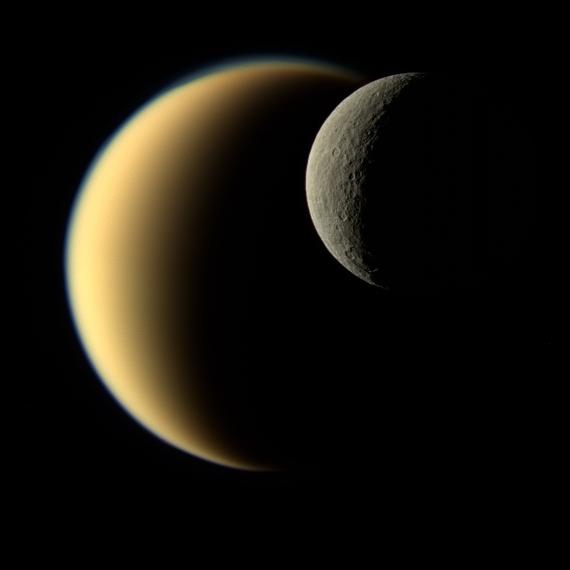Choppering Around the Titan Moon
Space travel is a great way to get from point A to point B when those points are worlds apart. But how do you move around once you get there?
They didn’t, at first. The Surveyor lunar landers in the 1960s used cameras for peering into the distance. The first half dozen Apollo program moonwalking astronauts used their legs for getting around. The rest of them hauled a dune buggy-like “rover” up to the moon. The rover let the astronauts travel for miles around the landing sites.
The then-Soviet Union was the first to successfully land a robotic rover on the moon in the 1970s with their Lunokhod program. After an initial launch failure dumped radioactive polonium across mother USSR, the following rovers that succeeded traveled for limited distances taking photos and other measurements along the way.
The current and ongoing glory days of roving vehicles began more than two decades ago on Mars with the shoebox-sized Sojourner rover. At the turn of the century came the twin rovers Sprit and Opportunity, followed another decade later by Curiosity. The latest U.S. Mars rover is Perseverance, whose scheduled launch at the time of this writing is July 30.
Looking back, however, the total distance traveled by the three successful Mars rovers mentioned above was just over 47 miles. Not that much compared with the size of the entire planet. What better ways are there to get around?
Astronomy popularizer Carl Sagan mused in his landmark book and miniseries “Cosmos” about the possibility of life forms whose bodies were basically gas bags that could float and maneuver slowly around in the upper atmosphere of Jupiter. Picture giant floating jellyfish hanging high in the air.
Lighter than air airships were employed in Kim Stanley Robinson’s Mars Trilogy science fiction novels. In them, as Mars’ atmosphere thickened due to terraforming, airships were employed for navigating the Martian world.
These concepts are definitely exotic. And even more so are upcoming plans for remotely exploring Saturn’s largest moon Titan. Titan and its thick nitrogen & methane atmosphere was previously probed by the European Space Agency’s (ESA) Huygens landing vehicle.

NASA has made Titan part of its long-range plan for solar system exploration. However, NASA won’t be satisfied just sitting around taking photos once it gets there. Instead of the usual wheeled rover, the Dragonfly mission will take to the air. The vehicle has four propellers and looks like a drone or quadcopter. It will travel around Titan searching for possible signs of any kind of prior or current life.
I like flying my remote-controlled quadcopter at home. It’s so tiny and light that it is only flown indoors where it is safe from the random whims of the breeze outdoors. It is hard enough for me to fly it, but Dragonfly has some very unforgiving constraints.
For example, even when at it’s closest to Earth, at opposition, light and radio signals take 75 minutes to travel between Earth and Saturn. At greater distances the travel time increases. Thus, the minimum time for an emergency situation on Titan to be communicated to Earth, and for the responsive commands to be transmitted to and reach Titan, is a minimum of 2 ½ hours. Thus, the Dragonfly drone has to be fully autonomous, not simply remote controlled like my quadcopter.
Dragonfly’s launch is planned for 2026 and not arriving at Titan until 2034. The anticipated mission duration is 2.7 years, but will hopefully be extended if successful. Dragonfly is being developed in Maryland at The Johns Hopkins University Applied Physics Laboratory (JHU-APL).
Those wishing to learn more about Dragonfly might want to attend the Wednesday, August 12 meeting of the Westminster Astronomical Society (WASI). Planetary geologist and Dragonfly project scientist Scott Murchie (JHU-APL) will be the guest speaker at the meeting, starting at 7:30 p.m.
WASI’s normal meeting location, Bear Branch Nature Center, has been closed due to the Covid-19 lockdown. August will be the 5th general meeting in a row that WASI has used the Zoom conferencing application for conducting business. WASI general monthly meetings are free and open to the public.
More information about the free online meeting, including the Zoom meeting ID, can be found by browsing to westminsterastro.org, clicking on the Calendar link and scrolling down. (Go to zoom.us to download the Zoom client software if you don’t already have it.) The online session will be active 30 minutes prior to meeting start time.
–Curt Roelle
